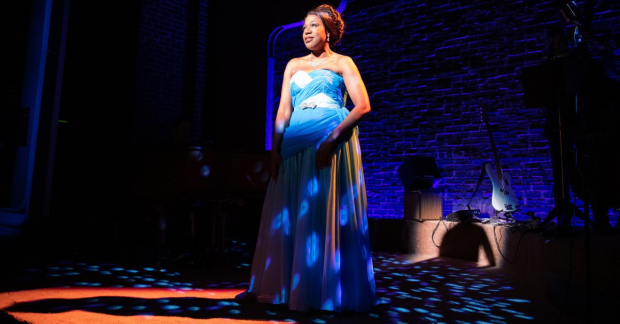Review: Little Girl Blue Looks at the Life of Musician and Civil Rights Activist Nina Simone
Laiona Michelle’s new musical is running at New World Stages.

(© Julieta Cervantes)
Nina Simone has often been classified as a "jazz" musician, a label she said she was given because she was Black. But no category quite defines Simone or her music. She was as complex as the Bach-style fugues she sometimes wove into her songs (Johann Sebastian was her life's great love).
That's one aspect of Simone that Laiona Michelle emphasizes in her impressive if overambitious juke-box musical Little Girl Blue (Simone recorded most of the show's songs), now running at New World Stages under the direction of Devanand Janki. Michelle uses the cabaret format to take us from Simone's girlhood when she began playing classical piano and fell in love with Bach to her self-exile in Switzerland where she found some respite from America's racism. A tireless advocate of civil rights, Simone as a musician and as a staunch warrior for justice gets her due in this show.
If any life lends itself to juke-box musical treatment, it's Simone's, but it's a tall order for one person to pull off, and that turns out to be the case here. Michelle is accompanied onstage by a band (keyboardist Mark Fifer, bassist Saadi Zain, and percussionist Kenneth Salters), but she carries most of the exhausting weight of the two-hour-plus show, which comprises two concerts: one in Westbury, New York, in 1968, just days after Martin Luther King Jr. was assassinated, and the other in Montreaux, Switzerland, in 1976 (Shoko Kambara designed the brick-facade nightclub where Simone performs).
Janki creates real tension in this first scene, rushing Simone, wearing a blue evening dress (costumes by Ari Fulton), onto the stage accompanied by police officers who are there to maintain some semblance of peace as a near riot takes place outside in the wake of King's death. Bitter irony fills her first two songs, "Feeling Good" and "Love Me or Leave Me," after which she says to the audience, "Look at all these groovy white people. I can always count on you. White people have always enjoyed my music and my pain." You never had to wonder what Simone was thinking. She told you.

(© Julieta Cervantes)
That's a sense of the atmosphere Michelle creates in the show's first set, which includes the famous protest song "Ain't Got No—I Got Life" and a song written by Michelle but performed as though Simone sang it, "Angry Black Woman," which harks to Simone's first and perhaps most famous protest song "Mississippi Goddam" (why not that song instead?). Tempering the politics are numbers that illustrate Simone's life, from her strained relationship with her father ("My Father") to her marriage to a cop who abused her physically and emotionally ("I Put a Spell on You").
The show becomes more heavy-handed when it moves to Switzerland, and the story delves into Simone's troubled life and violent marriage (her husband beat and raped her when he suspected her of a lesbian affair). Here, Dawn Chiang's elaborate lighting design becomes phantasmagoric as Michelle reels onstage in a hallucination-like rendition of "Ne Me Quitte Pas." As she did in the first act, Michelle uses flashbacks to reenact episodes from Simone's life with impersonations of other people, to mixed effect. This episode, however, breaks the spell of the nightclub venue completely and drains some of the magic from the stage.
Fortunately, things get back on track with the story of 12-year-old budding classical pianist Eunice Kathleen Waymon (Simone's birth name), who wouldn't play a note at a concert until her mother was allowed to sit in the front with the white people ("Ooh Child"), illustrating the one constant in her life from her earliest years: She demanded fairness and respect, for herself and all people of color.
Though Little Girl Blue (also the title of Simone's first album) feels crammed with more biography than it can comfortably contain, Michelle's performance holds us. Her singing voice is brassier than Simone's sultry contralto, and her re-creation of Simone's onstage presence has an exaggerated awkwardness, but we always feel the spirit of the legendary performer emanating from the music (Twi McCallum's clear sound design magnifies every plink on the piano). Fittingly, the number "My Way" ends the show, a triumphant flourish for an artist who refused to be defined — Simone's story in one song.









